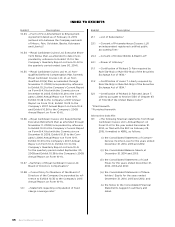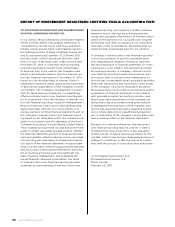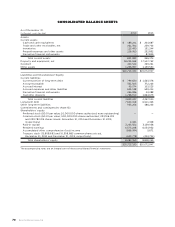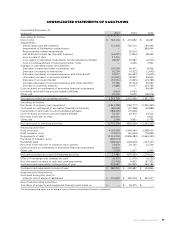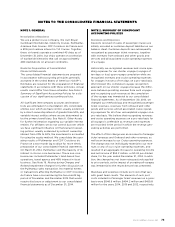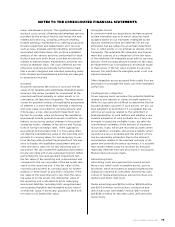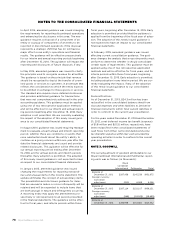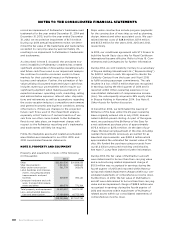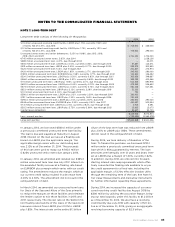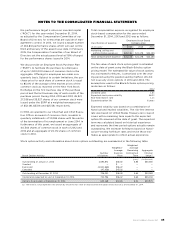Royal Caribbean Cruise Lines 2014 Annual Report Download - page 76
Download and view the complete annual report
Please find page 76 of the 2014 Royal Caribbean Cruise Lines annual report below. You can navigate through the pages in the report by either clicking on the pages listed below, or by using the keyword search tool below to find specific information within the annual report.
Royal Caribbean Cruises Ltd. 75
NOTES TO THE CONSOLIDATED FINANCIAL STATEMENTS
major maintenance activity. The significant deferred
drydock costs consist of hauling and wharfage services
provided by the drydock facility, hull inspection and
related activities (e.g., scraping, pressure cleaning,
bottom painting), maintenance to steering propulsion,
thruster equipment and ballast tanks, port services
such as tugs, pilotage and line handling, and freight
associated with these items. We perform a detailed
analysis of the various activities performed for each
drydock and only defer those costs that are directly
related to planned major maintenance activities nec-
essary to maintain Class. The costs deferred are not
otherwise routinely periodically performed to main-
tain a vessel’s designed and intended operating capa-
bility. Repairs and maintenance activities are charged
to expense as incurred.
Goodwill
Goodwill represents the excess of cost over the fair
value of net tangible and identifiable intangible assets
acquired. We review goodwill for impairment at the
reporting unit level annually or, when events or cir-
cumstances dictate, more frequently. The impairment
review for goodwill consists of a qualitative assessment
of whether it is more-likely-than-not that a reporting
unit’s fair value is less than its carrying amount, and
if necessary, a two-step goodwill impairment test.
Factors to consider when performing the qualitative
assessment include general economic conditions, lim-
itations on accessing capital, changes in forecasted
operating results, changes in fuel prices and fluctua-
tions in foreign exchange rates. If the qualitative
assessment demonstrates that it is more-likely-than-
not that the estimated fair value of the reporting unit
exceeds its carrying value, it is not necessary to per-
form the two-step goodwill impairment test. We may
elect to bypass the qualitative assessment and pro-
ceed directly to step one, for any reporting unit, in
any period. We can resume the qualitative assessment
for any reporting unit in any subsequent period. When
performing the two-step goodwill impairment test,
the fair value of the reporting unit is determined and
compared to the carrying value of the net assets allo-
cated to the reporting unit. If the fair value of the
reporting unit exceeds its carrying value, no further
analysis or write-down of goodwill is required. If the
fair value of the reporting unit is less than the carry-
ing value of its net assets, the implied fair value of
the reporting unit is allocated to all its underlying
assets and liabilities, including both recognized and
unrecognized tangible and intangible assets, based
on their fair value. If necessary, goodwill is then writ-
ten down to its implied fair value.
Intangible Assets
In connection with our acquisitions, we have acquired
certain intangible assets to which value has been
assigned based on our estimates. Intangible assets
that are deemed to have an indefinite life are not
amortized, but are subject to an annual impairment
test, or when events or circumstances dictate, more
frequently. The indefinite-life intangible asset impair-
ment test consists of a comparison of the fair value
of the indefinite-life intangible asset with its carrying
amount. If the carrying amount exceeds its fair value,
an impairment loss is recognized in an amount equal
to that excess. If the fair value exceeds its carrying
amount, the indefinite-life intangible asset is not con-
sidered impaired.
Other intangible assets assigned finite useful lives are
amortized on a straight-line basis over their estimated
useful lives.
Contingencies—Litigation
On an ongoing basis, we assess the potential liabilities
related to any lawsuits or claims brought against us.
While it is typically very difficult to determine the tim-
ing and ultimate outcome of such actions, we use our
best judgment to determine if it is probable that we
will incur an expense related to the settlement or
final adjudication of such matters and whether a rea-
sonable estimation of such probable loss, if any, can
be made. In assessing probable losses, we take into
consideration estimates of the amount of insurance
recoveries, if any, which are recorded as assets when
recoverability is probable. We accrue a liability when
we believe a loss is probable and the amount of loss
can be reasonably estimated. Due to the inherent
uncertainties related to the eventual outcome of liti-
gation and potential insurance recoveries, it is possible
that certain matters may be resolved for amounts
materially different from any provisions or disclosures
that we have previously made.
Advertising Costs
Advertising costs are expensed as incurred except
those costs which result in tangible assets, such as
brochures, which are treated as prepaid expenses and
charged to expense as consumed. Advertising costs
consist of media advertising as well as brochure, pro-
duction and direct mail costs.
Media advertising was $205.2 million, $205.8 million
and $200.9 million, and brochure, production and
direct mail costs were $136.7 million, $137.1 million
and $130.4 million for the years 2014, 2013 and 2012,
respectively.



